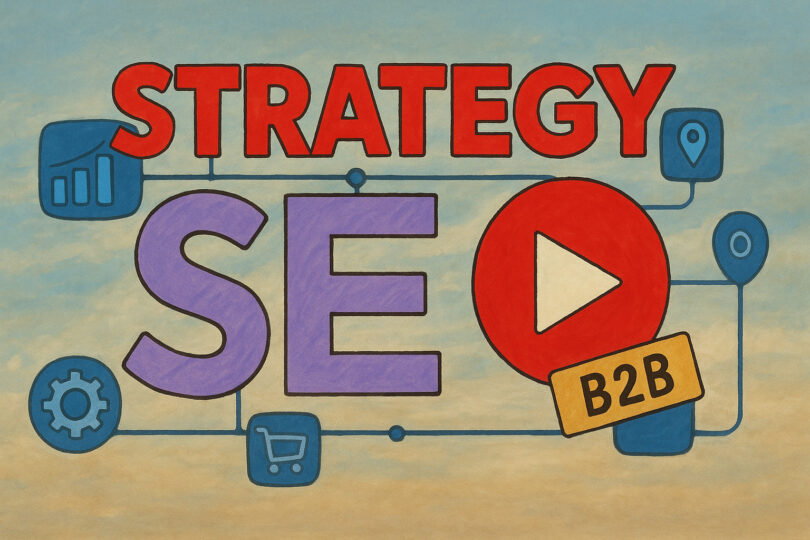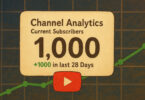In today’s digital-first world, B2B buyers are more informed than ever. Before reaching out to a sales rep, they research solutions online—watching product demos, reading case studies, and viewing explainer videos. And where do they often go? YouTube . With over 2.7 billion logged-in monthly users , YouTube isn’t just for viral cat videos—it’s a goldmine for B2B marketers looking to connect with decision-makers at every stage of the buyer’s journey.
But simply uploading content isn’t enough. To stand out in this crowded space, you need a strategic approach for B2B YouTube SEO that helps your videos rank higher, reach the right audience, and convert viewers into customers.
By the end of this guide, you’ll understand:
- Why YouTube SEO is crucial for B2B growth
- How to optimize your B2B YouTube channel for search engines
- The best practices for keyword research and video metadata
- How to structure your content strategy for maximum impact
- Tools and tactics to measure and refine your YouTube SEO efforts
Let’s dive in and turn your YouTube presence into a lead-generating powerhouse.
Understanding the Role of YouTube in the B2B Buyer’s Journey
Before jumping into optimization strategies, it’s essential to recognize how YouTube fits into the B2B sales funnel . Unlike B2C audiences, B2B buyers typically go through a longer, more complex decision-making process. They rely heavily on educational content to evaluate products, compare vendors, and justify purchases internally.
Here’s how YouTube plays a role at each stage:
| Funnel Stage | Content Type | Purpose |
|---|---|---|
| Awareness | Explainer videos, thought leadership | Introduce your brand and address pain points |
| Consideration | Product demos, use cases, comparisons | Showcase how your solution solves specific problems |
| Decision | Testimonials, case studies, ROI calculators | Provide social proof and help finalize decisions |
YouTube allows you to meet your audience where they are, delivering targeted content that nurtures them from awareness to conversion—all while improving your brand visibility and credibility.
Why Traditional SEO Isn’t Enough Enter YouTube SEO
While general SEO strategies focus on optimizing websites and blogs, YouTube SEO requires a different approach. It involves optimizing not only the video content but also the surrounding elements like titles, descriptions, tags, thumbnails, and engagement metrics.
Search engines like Google treat YouTube as its own platform and often feature YouTube videos in search results , especially for how-to guides, tutorials, and reviews. For B2B brands, this presents an opportunity to appear in both Google and YouTube search results , doubling your chances of being seen by potential customers.
Key Components of a Winning B2B YouTube SEO Strategy
A strong B2B YouTube SEO strategy consists of several interlinked components working together to boost discoverability and engagement. Let’s break down each one.
1. Conducting B2B-Focused Keyword Research for YouTube
Just like with traditional SEO, keyword research is the foundation of any successful YouTube SEO campaign. But when targeting B2B audiences, your keywords will be more niche, industry-specific, and intent-driven.
Tools to Use:
- Google Keyword Planner – Great for understanding search volume and competition.
- Ahrefs or SEMrush – Ideal for competitor analysis and long-tail keyword discovery.
- TubeBuddy or VidIQ – Designed specifically for YouTube SEO, offering real-time keyword suggestions.
Tips for Finding B2B Keywords:
- Focus on long-tail keywords like “how to choose CRM software for small business” rather than generic terms like “CRM.”
- Look for questions people ask in forums like Quora, Reddit, or LinkedIn groups.
- Analyze competitors’ top-performing videos and see what keywords they’re ranking for.
Example:
If you’re a cybersecurity SaaS company, instead of targeting “cybersecurity,” aim for phrases like:
- “How to implement zero-trust security architecture”
- “Best endpoint protection for enterprise networks”
- “Cybersecurity compliance checklist for financial institutions”
These types of queries signal high purchase intent and are more likely to attract qualified B2B leads.
2. Optimizing Video Titles for Click-Through Rate and SEO
Your video title is the first thing viewers see—and it plays a critical role in both click-through rate (CTR) and SEO performance.
Best Practices:
- Include your primary keyword near the beginning of the title.
- Keep it under 60 characters to avoid truncation.
- Make it compelling and benefit-driven.
Examples:
✅ Good: “How to Build a B2B Marketing Funnel [Step-by-Step Guide]”
❌ Bad: “Marketing Funnel Explained”
Use power words like “Guide,” “Tutorial,” “Checklist,” or “Tips” to attract attention and set expectations.
3. Writing SEO-Friendly Video Descriptions
The video description gives context to both viewers and search engines. A well-crafted description can improve rankings, encourage engagement, and even drive traffic to your website.
Structure Your Description Like This:
- Opening paragraph : Summarize the video content and include your main keyword.
- Timestamps : Break down the video into sections for easy navigation.
- Links : Add links to your website, landing pages, or related videos.
- Hashtags : Include 2–5 relevant hashtags to help categorize your content.
Example:
In this video, we walk through the step-by-step process of creating a data-driven B2B marketing funnel. Whether you’re a startup or enterprise-level business, this guide will show you how to align your content strategy with customer needs and drive measurable results.
🔍 Timestamps:
0:00 – Introduction
1:30 – Understanding the B2B buyer journey
4:15 – Building your funnel stages
8:00 – Measuring success📲 Want to learn more about our B2B marketing services? Visit yourwebsite.com/b2b-marketing
4. Choosing the Right Tags for Each Video
Tags help YouTube understand what your video is about and which audience to show it to. While they’re not as influential as they once were, they still play a supporting role in YouTube SEO.
Tag Tips:
- Use a mix of broad and long-tail keywords.
- Include branded terms if applicable.
- Don’t overdo it—stick to 8–12 relevant tags per video.
Example tags for a B2B marketing video:
- “B2B marketing funnel”
- “lead generation strategy”
- “content marketing for SaaS”
- “marketing automation tools”
- “customer acquisition funnel”
5. Creating Custom Thumbnails That Convert
While not directly part of SEO, thumbnails significantly affect your video’s CTR and watch time—two key ranking factors.
Thumbnail Design Tips:
- Use high-contrast colors and bold text.
- Show human emotion or curiosity.
- Avoid clutter—keep it clean and readable.
Tools like Canva , Adobe Express , or Snappa make it easy to design professional-looking thumbnails tailored to your brand.
6. Encouraging Engagement Through Calls-to-Action
Engagement signals like likes, comments, shares, and watch time are crucial for YouTube’s algorithm. Encourage interaction by including clear calls-to-action (CTAs) in your videos.
Types of CTAs:
- “Like this video if you found these tips helpful!”
- “Comment below with your biggest challenge in lead generation.”
- “Subscribe for more B2B marketing insights.”
You can also use end screens and cards to promote other videos or your website.
Structuring Your B2B YouTube Content Strategy
Creating great SEO-optimized videos is just one piece of the puzzle. To truly succeed, you need a cohesive content strategy that aligns with your overall B2B marketing goals.
Step 1: Define Your Target Personas
Start by identifying who you’re trying to reach. Are you targeting:
- IT managers?
- CFOs?
- HR directors?
- CMOs?
Each persona has unique pain points, challenges, and buying behaviors. Tailor your video topics accordingly.
Step 2: Map Content to the Buyer’s Journey
Create a content calendar that supports your audience throughout their journey:
- Top of Funnel (TOFU) : Educational content like webinars, whiteboard animations, and explainers.
- Middle of Funnel (MOFU) : Product walkthroughs, case studies, and comparison videos.
- Bottom of Funnel (BOFU) : Testimonials, pricing breakdowns, and demo videos.
This ensures your content is timely, relevant, and valuable.
Step 3: Leverage Playlists to Organize Content
Playlists help keep your content organized and improve viewer retention. Group similar videos together under themed playlists such as:
- “B2B Marketing Strategies”
- “SaaS Product Demos”
- “Industry Trends & Insights”
Each playlist acts like a mini-channel, boosting SEO and increasing time spent on your page.
Step 4: Repurpose Blog Content Into Videos
Don’t let your blog posts go to waste. Turn popular articles into engaging videos. For example:
- Convert a blog post titled “10 B2B Lead Generation Mistakes” into a video format.
- Use infographics or screen recordings to visually present data.
This not only saves time but also maximizes the reach of your existing content.
Step 5: Promote Videos Across Channels
Maximize visibility by promoting your videos across all your marketing channels:
- Embed them in blog posts and landing pages
- Share them on LinkedIn, Twitter, and Facebook
- Include them in email newsletters
- Run paid ads targeting high-intent keywords
Cross-promotion increases views, engagement, and backlinks—key factors for YouTube SEO.
Advanced B2B YouTube SEO Tactics
Once you’ve mastered the basics, it’s time to level up your strategy with advanced techniques that give you a competitive edge.
1. Optimize for Featured Snippets and Google Discover
Many YouTube videos appear in Featured Snippets and Google Discover , driving traffic from outside the YouTube platform. To increase your chances:
- Create concise, informative answers to common questions
- Use structured formatting in your description
- Ensure your video thumbnail and title match the query intent
2. Use Transcripts and Closed Captions
Adding transcripts and closed captions improves accessibility and gives YouTube more context about your video content. You can upload a transcript manually or auto-generate one using YouTube’s tools.
Pro Tip: Incorporate keywords naturally within your script to boost relevance without stuffing.
3. Monitor Analytics and Adjust Your Strategy
YouTube Studio offers rich analytics that can help you understand what’s working and what’s not.
Key Metrics to Track:
- Watch time
- Audience retention
- Click-through rate (CTR)
- Traffic sources
- Search impressions vs. clicks
Use this data to refine your content strategy, test new formats, and double down on what resonates with your audience.
4. Collaborate with Industry Influencers
Partnering with influencers or subject matter experts can expand your reach and enhance credibility. When choosing collaborators, look for individuals who resonate with your target personas—even if they don’t have millions of followers.
Guest interviews, co-hosted webinars, and expert panels are excellent ways to diversify your content and tap into new audiences.
5. Create Evergreen Content
While trending topics can bring short-term traffic, evergreen content continues to deliver value over time. Focus on creating videos that remain relevant for months or even years, such as:
- Industry overviews
- How-to guides
- Product tutorials
- Strategic frameworks
Evergreen videos tend to rank better in the long run and provide consistent lead generation.
Common Mistakes B2B Marketers Make with YouTube SEO
Even with the best intentions, many B2B companies fall into traps that hurt their YouTube SEO performance. Here are some common mistakes to avoid:
1. Ignoring Audience Intent
Not all views are equal. If your video targets a broad audience with vague messaging, it won’t convert. Always align your content with the search intent behind the keyword.
2. Overlooking Mobile Optimization
With 70% of YouTube watch time coming from mobile devices , your content must be optimized for smaller screens. Ensure your thumbnails, titles, and visuals are mobile-friendly.
3. Failing to Optimize Channel Pages
Your YouTube channel homepage should reflect your brand and make it easy for visitors to explore your content. Customize your banner, create curated playlists, and link to your website.
4. Publishing Inconsistently
Consistency builds trust and keeps your audience engaged. Develop a publishing schedule and stick to it—even if it’s just one video per month.
5. Not Tracking Performance
Failing to analyze your YouTube analytics means missing out on opportunities to improve. Set up goals, track conversions, and adjust based on real data—not guesswork.
Tools Every B2B Marketer Should Use for YouTube SEO
To streamline your YouTube SEO workflow and maximize results, consider integrating these tools into your strategy.
| Tool | Purpose | Free/Paid |
|---|---|---|
| TubeBuddy | Keyword research, bulk editing, A/B testing | Free + Paid Plans |
| VidIQ | SEO analyzer, competitor insights, video ideas | Free + Paid Plans |
| Ahrefs/SEMrush | Keyword research, competitor analysis | Paid |
| Google Trends | Understand seasonal trends | Free |
| Canva | Thumbnail creation | Free + Pro |
| Descript | Video editing and transcription | Free + Paid Plans |
| Zapier | Automate workflows between apps | Free + Paid Plans |
Using these tools can save time, improve efficiency, and give you deeper insights into your YouTube performance.
Case Studies: Real B2B Brands Crushing YouTube SEO
Still unsure if YouTube SEO works for B2B? Take inspiration from these companies that have successfully leveraged YouTube to grow their businesses.
1. HubSpot – Thought Leadership at Scale
HubSpot consistently ranks for keywords like “what is inbound marketing” and “how to build a sales funnel.” Their YouTube strategy focuses on educational content, featuring experts and actionable advice that speaks directly to marketers and sales professionals.
2. Salesforce – Product Demos Done Right
Salesforce uses YouTube to showcase product features, integrations, and customer stories. Their videos are highly optimized with detailed descriptions, timestamps, and clear CTAs that direct viewers to their website.
3. Drift – Conversational Marketing Made Simple
Drift’s YouTube channel is filled with short, punchy videos explaining conversational marketing concepts. They use catchy thumbnails, fast-paced editing, and strong CTAs to engage their audience and drive sign-ups.
Final Thoughts: YouTube SEO Is a Must-Have for B2B Growth
In the evolving landscape of B2B marketing, YouTube SEO isn’t optional—it’s essential . By strategically optimizing your videos, organizing your content, and engaging your audience, you can position your brand as a thought leader, attract high-quality leads, and drive sustainable growth.
Remember, success doesn’t come overnight. It takes consistency, experimentation, and a willingness to adapt. Start with one video, optimize it thoroughly, and gradually scale your efforts based on what works.
Whether you’re a startup or an enterprise, investing in YouTube SEO now will pay dividends for years to come.
Frequently Asked Questions (FAQ)
Q: Is YouTube good for B2B marketing?
Yes! YouTube is a powerful platform for B2B marketing, especially for educating prospects, showcasing expertise, and building brand authority.
Q: How long does it take to see results from YouTube SEO?
It typically takes 3–6 months to see noticeable improvements in rankings and traffic, depending on your consistency and competition.
Q: What kind of videos perform best for B2B brands?
Educational content like tutorials, case studies, product demos, and thought leadership videos tend to perform best for B2B audiences.
Q: How often should I post videos on YouTube for B2B?
Aim to publish at least once a month to maintain consistency and stay top-of-mind with your audience.
Q: Do B2B companies need a YouTube channel?
Absolutely. A YouTube channel enhances your online presence, improves SEO, and provides a centralized hub for all your video content.
Ready to Elevate Your B2B YouTube SEO Strategy?
Now that you’ve got the roadmap, it’s time to start implementing. Begin by auditing your current YouTube presence, researching high-intent keywords, and crafting a content plan that speaks directly to your ideal clients.
Stay consistent, measure your results, and always keep your audience’s needs at the center of your strategy. With time and effort, your YouTube channel can become one of your most powerful B2B marketing assets.
Got questions or want help building your B2B YouTube SEO strategy? Leave a comment below or reach out—we’d love to help!








Leave a Comment